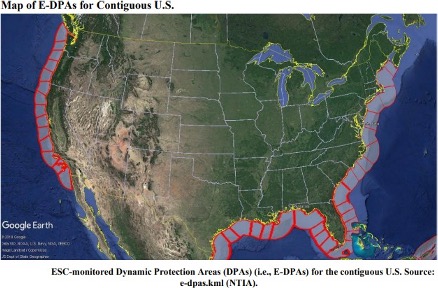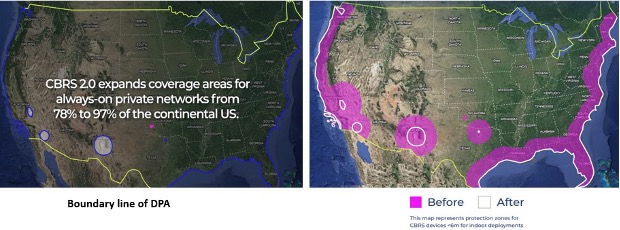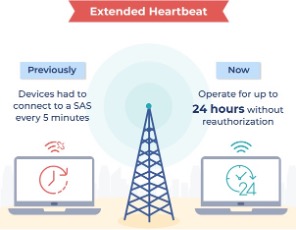The Citizens Broadband Radio Service (CBRS) encompasses 150 megahertz of spectrum in the 3.5 GHz band (3550 MHz–3700 MHz), with plans to expand by an additional 100 megahertz. Historically, this spectrum has been actively utilized by the U.S. government and the Coast Guard. Since 2020, the Federal Communications Commission (FCC) has classified CBRS as an “unlicensed spectrum” for shared wireless private broadband.
The FCC established two tiers for spectrum access: General Authorized Access (GAA) and Priority Access Licenses (PAL). The GAA tier provides “free” spectrum allocation of 80 MHz within the 150 MHz band, while the PAL tier consists of licensed spectrum segments acquired through auction. PAL licenses, which consist of 10-MHz unpaired channels within the 3.55-3.65 GHz range, are dynamically assigned by the Spectrum Access System (SAS) and are issued on a county-level basis for a 10-year term. During the auction, approximately 20,625 licenses were sold, generating revenue exceeding $4.5 billion.
However, this investment is accompanied by significant regulatory constraints. In areas designated for military operations, Dynamic Protection Areas (DPAs) have been established to safeguard incumbent radar systems. Within these DPAs, CBRS operations over specified frequency ranges are prohibited whenever radar systems are active. Each DPA is defined by a frequency range where radar operations may occur, and all points within the DPA must be protected from interference, whether by co-channel or out-of-band (OOB) CBRS emissions.
One of the primary challenges for service providers is the restriction on CBRS operations in large incumbent-protected areas. When incumbent transmissions commence, CBRS service in these areas must cease, creating significant coverage gaps and operational limitations for service providers.
Figure 1: Dynamic Protection Areas (DPAs) in the continental U.S.

In the CBRS 1.0 framework, the heartbeat interval and transmit expiry timer posed significant challenges for service providers. The CBSD (Citizens Broadband Service Device) periodically sends a heartbeat request to the SAS (Spectrum Access System), typically at intervals of 5 minutes or longer, to maintain its spectrum grant. In response, the SAS provides a heartbeat response, which includes the transmit expiry time — the time at which the CBSD must cease transmissions if no further authorization is received, plus a 60-second grace period. If the CBSD fails to receive a response or re-synchronize with the SAS before the timer expires, it must stop transmitting, resulting in a service outage. This process, critical for spectrum management, often created disruptions, especially in cases of network instability or latency, leading to interruptions in CBSD operations until the SAS link was re-established.

The short duration of the “transmit expiry timer” has been a significant concern, as it can lead to service outages. If the timer expires and the CBSD (Citizens Broadband Service Device) fails to re-synchronize with the SAS (Spectrum Access System) server, the CBSD will cease operation and remain offline until the CBSD-SAS link is re-established.
Another critical issue is interference. As CBRS operates as an “unlicensed spectrum,” multiple CBSDs often transmit simultaneously in close proximity, leading to potential interference. To mitigate this, techniques such as the unicast topology have been implemented, wherein all CBSDs transmit uplink and downlink simultaneously using TDD (Time Division Duplex) to prevent cross-link interference. While the PAL spectrum is safeguarded through designated PAL Protection Areas (PPAs), the GAA spectrum remains unprotected except through controls implemented by the SAS server or mechanisms like the “GAA-Coexistence” group.
The FCC has addressed these challenges in its latest guidelines, as outlined in several public notices.
The redesign of Dynamic Protection Areas has significantly reduced their size compared to the original CBRS 1.0 framework. This reduction ensures that CBRS operations can expand while continuing to protect military systems. Smaller protection zones mean more locations are now available for CBRS operations. Devices that previously experienced interruptions due to incumbent activities can now operate without the risk of preemption, ensuring consistent connectivity. For indoor deployments below 6 meters, the percentage of the population outside protection zones is projected to increase from 49% to 91%.
By successfully implementing these changes, SAS administrators are expected to authorize service for approximately 72 million additional people, bringing the total nationwide coverage to an estimated 240 million.
Figure 2: Comparison of DPA zones for CBSD under 6 meters for indoor deployments before (purple) and after (white) the implementation of new guidelines or CBRS 2.0.

The other issue of Heartbeat interval along with transmit expiry timer is relaxed now. As per the new NTIA guidelines, “lengthening this reauthorization period from five minutes to 24 hours that are outside of the scope of current federal operations will help to provide a more stable and predictable spectrum environment for all CBSD devices of any category (Cat-A/Cat-B).
Figure 3: Comparison of CBSD periodic timer before & after the implementation of new rules or CBRS 2.0.

Though it is strongly recommended not to use a 24-hour long wait period, instead most OEM prefers up to six hours at maximum without the need to reauthorize from SAS server. Also, the “transmit expiry timer” can be set to a maximum of 24 hours for the entire band outside DPA zones and within the upper
50 MHz spectrum range. The benefit from this approach in mitigating the potential for service disruptions, ensuring even more consistent and reliable connectivity for CBRS users specially for Mission critical use cases.
The last one is Interference management for GAA CBSD devices. As per the new guidelines, an optional coexistence mechanism is proposed to be implemented within SAS to help in enforcing frequency planning and interference restrictions across CBSDs in coordination with GAA operators. There is already a Collaborative GAA Coexistence framework defined in On-Go Alliance which included the following events:
- Interference Detection and Validation
- Creation of GAA Coordination Area
- GAA Frequency Plan and GAA Frequency Plan Negotiation
- Implementation of the GAA-negotiated frequency Plan
The newly added procedures for SAS server in CBRS 2.0 are the following:
- The SAS administrators may assume an 80% TDD activity factor and 20% network loading factor for each CBSD in the aggregate interference calculation. The total impact will reduce, by 8 dB, the equivalent EIRP used in the aggregate interference calculations for each CBSD by SAS.
- The SAS administrators may use median Irregular Terrain Model (ITM) terrain-dependent propagation loss (in dB) — using reliability and confidence factors of 0.5 — to calculate the aggregate received power levels within a DPA which was previously 0.95.
- The SAS administrators may apply median clutter loss — calculated using the methodology described in Recommendation ITU-R P.2108,9 section 3.2 — for any CBSD with an antenna height Above Ground Level (AGL) of less than or equal to six meters, that is operating at a distance of at least 250 meters from a DPA boundary.
Conclusion — How will these changes transform existing CBRS deployments?
The new guidelines hold significant promise to enhance capacity, coverage and overall user experience. The reduction in DPA sizes is expected to substantially improve spectrum availability, particularly in coastal regions, leading to better coverage and capacity for operators. Enhanced interference mitigation, through a coordinated coexistence mechanism among GAA CBSDs, is poised to deliver a smoother and more reliable end-user experience. Furthermore, this improvement could be amplified if OEMs implement key modifications in 5G-DU (Layer 2 MAC) and 5G-NRT-RIC, enabling efficient management of intra-PLMN CBSDs for optimized interference handling. Collectively, these advancements position CBRS 2.0 as a pivotal step forward in delivering high-quality, dependable connectivity.

